
Fairton is an unincorporated community and census-designated place (CDP) located within Fairfield Township, in Cumberland County, in the U.S. state of New Jersey. It is part of the Vineland-Millville-Bridgeton Primary Metropolitan Statistical Area for statistical purposes. As of the 2010 United States Census, the CDP's population was 1,264.

The Lenape, also called the Lenni Lenape and Delaware people, are an Indigenous people of the Northeastern Woodlands, who live in the United States and Canada.
The Ramapough Mountain Indians, known also as the Ramapough Lenape Nation or Ramapough Lunaape Munsee Delaware Nation or Ramapo Mountain people, are a group of approximately 5,000 people living in and around the Ramapo Mountains of Bergen and Passaic counties in northern New Jersey and Rockland County in southern New York, about 25 miles (40 km) from New York City. They were recognized in 1980 by the state of New Jersey as the Ramapough Lenape Nation but are not recognized federally. Their tribal office is located on Stag Hill Road on Houvenkopf Mountain near Mahwah, New Jersey. Since January 2007, the chief of the Ramapough Lenape Nation has been Dwaine Perry.

The Algonquians are one of the most populous and widespread North American native language groups. They historically were prominent along the Atlantic Coast and in the interior regions along Saint Lawrence River and around the Great Lakes. This grouping consists of the peoples who speak Algonquian languages.

The Delaware languages, also known as the Lenape languages, are Munsee and Unami, two closely related languages of the Eastern Algonquian subgroup of the Algonquian language family. Munsee and Unami were spoken aboriginally by the Lenape people in the vicinity of the modern New York City area in the United States, including western Long Island, Manhattan Island, Staten Island, as well as adjacent areas on the mainland: southeastern New York State, eastern Pennsylvania, New Jersey, Connecticut, Maryland, and Delaware.
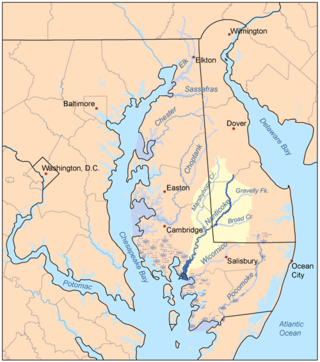
The Nanticoke people are a Native American Algonquian people, whose traditional homelands are in Chesapeake Bay and Delaware. Today they live in the Northeastern United States and Canada, especially Delaware; in Ontario; and in Oklahoma.
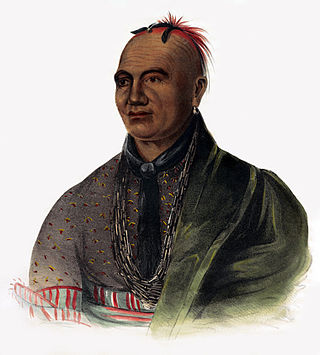
Indigenous peoples of the Northeastern Woodlands include Native American tribes and First Nation bands residing in or originating from a cultural area encompassing the northeastern and Midwest United States and southeastern Canada. It is part of a broader grouping known as the Eastern Woodlands. The Northeastern Woodlands is divided into three major areas: the Coastal, Saint Lawrence Lowlands, and Great Lakes-Riverine zones.

The Christian Munsee are a group of Lenape, an Indigenous people in the United States, that primarily speak Munsee and have converted to Christianity, following the teachings of Moravian missionaries. The Christian Munsee are also known as the Moravian Munsee or the Moravian Indians, the Moravian Christian Indians or, in context, simply the Christian Indians. As the Moravian Church transferred some of their missions to other Christian denominations, such as the Methodists, Christian Munsee today belong to the Moravian Church, Methodist Church, United Church of Canada, among other Christian denominations.

The Unalachtigo were a purported division of the Lenape, a Native American tribe whose homeland Lenapehoking was in what is today the Northeastern United States. They were part of the Forks Indians.

The Piscataway or Piscatawa, are Native Americans. They spoke Algonquian Piscataway, a dialect of Nanticoke. One of their neighboring tribes, with whom they merged after a massive decline of population following two centuries of interactions with European settlers, called them the Conoy.
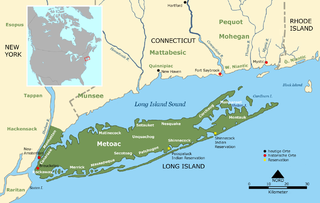
Metoac is an erroneous term used by some to group together the Munsee-speaking Lenape (west), Quiripi-speaking Unquachog (center) and Pequot-speaking Montaukett (east) American Indians on what is now Long Island in New York state. The term was invented by amateur anthropologist and U.S. Congressman Silas Wood in the mistaken belief that the various native settlements on the island each comprised distinct tribes.
Hackensack was the exonym given by the Dutch colonists to a band of the Lenape, or Lenni-Lenape, a Native American tribe. The name is a Dutch derivation of the Lenape word for what is now the region of northeastern New Jersey along the Hudson and Hackensack rivers. While the Lenape people occupied much of the mid-Atlantic area, Europeans referred to small groups of native people by the names associated with the places where they lived.
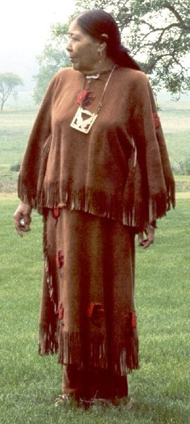
The Delaware Tribe of Indians, formerly known as the Cherokee Delaware or the Eastern Delaware, based in Bartlesville, Oklahoma, is one of three federally recognized tribes of the Lenape people in the United States. The others are the Delaware Nation based in Anadarko, Oklahoma, and the Stockbridge-Munsee Community of Wisconsin. More Lenape or Delaware people live in Canada.
The Choptank were an Algonquian-speaking Native American people that historically lived on the Eastern Shore of Maryland on the Delmarva Peninsula. They occupied an area along the lower Choptank River basin, which included parts of present-day Talbot, Dorchester and Caroline counties. They spoke Nanticoke, an Eastern Algonquian language closely related to Delaware. The Choptank were the only Indians on the Eastern Shore to be granted a reservation in fee simple by the English colonial government.

Nora Thompson Dean, also known as Weenjipahkihelexkwe, which translates as "Touching Leaves Woman" in Unami, was a member of the Delaware Tribe of Indians. As a Lenape traditionalist and one of the last fluent speakers of the southern Unami dialect of the Lenape language, she was an influential mentor to younger tribal members and is widely cited in scholarship on Lenape culture.
The Assateague were an Algonquian people speaking the Nanticoke language who historically lived on the Atlantic coast side of the Delmarva Peninsula.
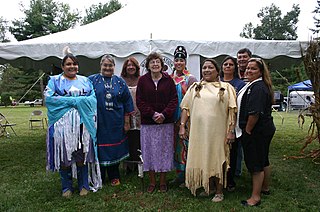
The Munsee are a subtribe and one of the three divisions of the Lenape. Historically, they lived along the upper portion of the Delaware River, the Minisink, and the adjacent country in New York, New Jersey, and Pennsylvania. They were prominent in the early history of New York and New Jersey, being among the first Indigenous peoples of that region to encounter European colonizers.

The Indigenous peoples of Maryland are the tribes who historically and currently live in the land that is now the State of Maryland in the United States of America. These tribes belong to the Northeastern Woodlands, a cultural region.










